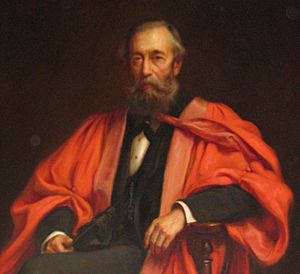Henry Clifton Sorby facts for kids
Quick facts for kids
Henry Clifton Sorby
|
|
|---|---|

Henry Clifton Sorby. Portrait in Mappin Hall, University of Sheffield
|
|
| Born | 10 May 1826 Woodbourne near Sheffield in Yorkshire, England
|
| Died | 9 March 1908 (aged 81) Sheffield, England
|
| Awards | Wollaston Medal (1869) Royal Medal (1874) |
Henry Clifton Sorby (born May 10, 1826 – died March 9, 1908) was a brilliant English scientist. He was a master of using microscopes and a skilled geologist. His most important work involved using microscopes to study iron and steel. This helped greatly with making steel in huge amounts, which changed industries forever.
Contents
About Henry Clifton Sorby
His Early Life
Henry Sorby was born in a place called Woodbourne, near Sheffield in Yorkshire, England. He went to school at Sheffield Collegiate School. From a young age, he loved natural science, which is the study of nature and the physical world.
When he was 21, in 1847, his father passed away. This left Henry with enough money to live comfortably. He quickly set up his own science lab and workshop at home. This allowed him to follow his passion for discovery.
Studying Rocks with Microscopes
Henry Sorby became one of the first people in England to study rocks and minerals using a microscope. This field is called petrography, which means "rock description." He wrote an important paper in 1858 about how crystals look under the microscope.
He was a pioneer in this area. Because of his amazing work, he received the Wollaston medal in 1869. This award is given by the Geological Society of London, and he later became its president. He also studied how limestone and other layered rocks formed.
Sorby was also the first to study how slate rocks split into thin layers, using a microscope. This splitting is called slaty cleavage. He once famously said, "Mountains must indeed be examined with the microscope." This showed how much he believed in looking closely at tiny details to understand big things.
He was one of the first to understand that tiny changes in materials can explain huge events. These events include how rocks deform or fold due to forces like tectonic uplift, which creates mountains. He even studied the tiny structures of meteorites, which are rocks from space.
Becoming the "Father of Metallography"
In 1863, Henry Sorby started using a special method called etching. This involved using acid to look at the tiny structure of iron and steel under a microscope. He was the first in England to figure out that a small, exact amount of carbon makes steel strong.
His observations helped prove that a new way of making steel was very good. This method was invented by Henry Bessemer and improved by Robert Forester Mushet. Thanks to Sorby's work, steel could be made in huge amounts. Because of this, he is known as the "father of metallography" today. Metallography is the study of the structure of metals. There is even an award named after him for achievements in this field.
Exploring the Ocean
Henry Sorby had many different interests. After he bought a yacht called "The Glimpse," he started studying the ocean. He looked at sedimentology, which is the study of how sediments (like sand and mud) are formed and moved. He also studied marine biology, which is the study of ocean life.
He measured water temperatures in places where rivers meet the sea, called estuaries. He also wrote about how to use a micro-spectroscope to study the colors of sea animals and plants. He even made special slides of small sea animals to show with a lantern projector. He once calculated that a tiny amount of water, "one cubic thousandth of an inch," contained an amazing number of molecules!
Joining Scientific Groups
In 1857, when he was only 31, Henry Sorby was chosen to be a Fellow of the Royal Society (FRS). This is a very high honor for scientists in the UK. He earned this for his work on slaty cleavage.
He also became the president of the Royal Microscopical Society. In 1882, he was elected president of Firth College in Sheffield. Sorby worked very hard to help create the University of Sheffield, which finally opened in 1905. A student residence hall at the university, Sorby Hall, was named after him.
His Passing
Henry Clifton Sorby passed away in Sheffield and was buried in Ecclesall churchyard.
Awards and Recognition
Henry Sorby received many honors for his scientific work. He was elected a Fellow of the Royal Society in 1857. This was because of his important papers on slaty cleavage, how currents affect rock layers, and the tiny structures of rocks.
He gave a special lecture called the Bakerian Lecture in 1863. He also received the Royal Medal in 1874. In 1892, he was made an honorary member of the American Academy of Arts and Sciences.
Two important groups, the International Association of Sedimentologists and the Yorkshire Geological Society, have "Sorby Medals" named after him. These medals honor his great achievements in geology. The International Metallographic Society also gives out the Henry Clifton Sorby Award for lifetime achievements in metallurgy.
The University of Sheffield has a special professor position in geology named after him. A local nature group, the Sorby Natural History Society [1], is also named in his honor. The area where they work is even called 'Sorbyshire' by its members.
On the Moon, a system of ridges called Dorsa Sorby is named after him. There is also a part of the Northern General Hospital in Sheffield named after him.
See also
 In Spanish: Henry Clifton Sorby para niños
In Spanish: Henry Clifton Sorby para niños
- Cleavage (crystal)
- Cleavage (geology)
- Dynamic quartz recrystallization
- Petrology
- Pressure solution
- Salt deformation
- Structural geology

